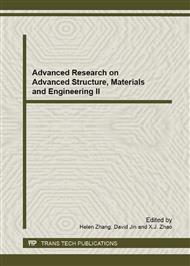[1]
A. Arkhireyeva, S.R. Hashemi: Effect of temperature on fracture properties of an amorphous poly (ethylene terephthalate) (PET) film. Journal of Materials Science Vol. 37(17) (2002), pp.3675-3683
DOI: 10.1023/a:1016561225281
Google Scholar
[2]
J.J. Strebel, V. Chellappa, A.A. Moet, et al: Measurement of fracture toughness from fatigue fracture studies. Annual Technical Conference-ANTEC, Conference Proceedings, Montreal, Canada: Soc of Plastics Engineers (1991), pp.2196-2199
Google Scholar
[3]
A.C. Orifici, R.S. Thomson, R. Degenhardtet, et al: Development of a finite-element analysis methodology for the propagation of delaminations in composite configurations. Mechanics of Composite Materials Vol. 43 (2007), pp.9-28
DOI: 10.1007/s11029-007-0002-6
Google Scholar
[4]
J.H. Park, S.N. Atluri: Mixed mode fatigue growth of curved cracks emanating from fastener holes in aircraft lap joints. Comput Mech Vol. 21 (1998), pp.477-482
DOI: 10.1007/s004660050326
Google Scholar
[5]
M.L. Williams: On the stress distribution at the base of a stationary crack. JSME (1957), pp.109-114
Google Scholar
[6]
G.C. Sih: Mathematical theories of brittle fracture in fracture an advanced treatise (Academic Press, New York, USA 1968)
Google Scholar
[7]
Rooke D P: Compounded Stress Intensity Factors for Cracks at as Fastener Holes. Eng. Fract. Mech. Vol. 19 (1984), p.359
DOI: 10.1016/0013-7944(84)90029-8
Google Scholar
[8]
Rooke D P: An Improved Compounding Method for Calculating Stress-Intensity Factors. Eng. Fract. Mech. Vol. 23 (1986), p.783
DOI: 10.1016/0013-7944(86)90090-1
Google Scholar
[9]
J. Schijve: Stress intensity factors of hole edge cracks comparison one crack and two symmetric cracks. International Journal of Fracture Fracture Vol. 23 (1983), pp.111-115
DOI: 10.1007/bf00028833
Google Scholar
[10]
J.F. Zhao, L.Y. Xie, J.Z. Liu and et al: A method for stress intensity factor calculation of infinite plate containing multiple hole-edge cracks. International Journal of Fatigue Vol. 35 (2012), pp.2-9
DOI: 10.1016/j.ijfatigue.2011.06.001
Google Scholar


